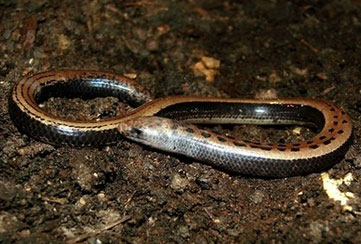Photo of new snake-like lizard discovered in India
New snake-like lizard discovered in India
mongabay.com
May 28, 2007
A previously unknown species of legless lizard as been discovered in a remote Indian forest, reports the Associated Press.
Sushil Kumar Dutta, leader of a team of researchers from NGO Vasundhra and the North Orissa University, found the 7-inch long creature in the forests of Khandadhar near Raurkela in Orissa state, about 625 miles southeast of New Delhi.
“Preliminary scientific study reveals that the lizard belongs to the genus Sepsophis,” Dutta told the Associated Press. “The lizard is new to science and is an important discovery. It is not found anywhere else in the world.”
The closest relatives of the newly discovered species are skinks found in Sri Lanka and South Africa.
 Photo by Indian zoologist Sushil Kumar Dutta |
Scientists say limbless forms of lizards have evolved independently several times, probably to facilitate underground movement. Most limbless lizards live under leaf litter or in upper levels of soil.
Limbless lizards are not snakes. They can be distinguished by their external ear holes and flat, non-forked tongues
Related articles
Blind pink snake discovered in Madagascar. A pink worm-like snake has been rediscovered in Madagascar more than 100 years after it was first found. The snake, which is blind and measures about ten inches long, is described in the February 1, 2007 edition of Zootaxa, a leading taxonomic journal.
Unknown species of lizard discovered in Borneo. A previously unknown species of lizard was discovered in Borneo by Chris Austin, assistant curator of herpetology at Louisiana State University’s Museum of Natural Science. The scientific name of the lizard, which was discovered while Austin was conducting field research in Sarawak, will be unveiled in the March 2007 edition of Journal of Herpetology. The discovery comes as Borneo’s rainforests are increasingly endangered by logging, clearing for oil palm plantations for biofuel, and agricultural fires.